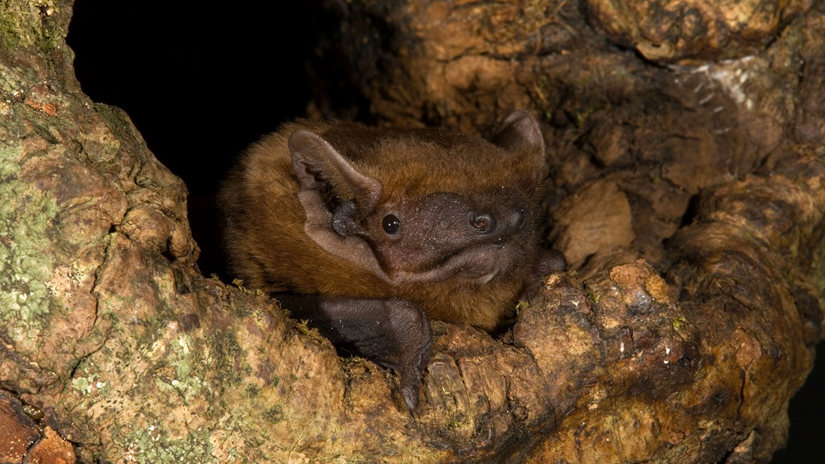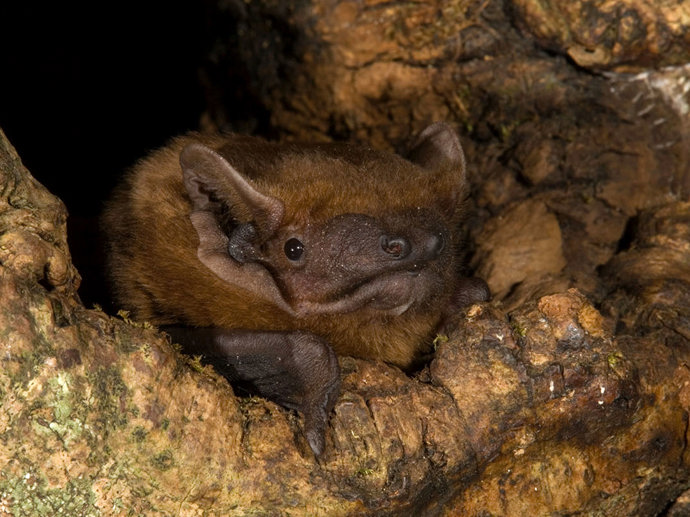Common name: common pipistrelle
Scientific name: Pipistrellus pipistrellus
Family: Vespertilionidae
Habitat: woodland, farmland, grassland, urban areas
Diet: invertebrates
Predators: birds of prey and domestic cats
Origin: native
Flying mammals that live among us. Common pipistrelles spend the day sleeping in buildings, but rely on trees when they emerge at night.
Common name: common pipistrelle
Scientific name: Pipistrellus pipistrellus
Family: Vespertilionidae
Habitat: woodland, farmland, grassland, urban areas
Diet: invertebrates
Predators: birds of prey and domestic cats
Origin: native
The common pipistrelle is a small bat, with brown fur and black wings and face. Its wingspan is normally around 20cm and it weighs no more than a pound coin.

Credit: FLPA / Alamy Stock Photo
Flies are the main prey of common pipistrelles, with lacewings, mayflies, midges and mosquitoes all on the menu. The bat catches these insects in flight, using echolocation (a biological sonar) to locate its prey and avoid flying into obstacles.
Common pipistrelles can fly at a speed of seven metres per second.
Common pipistrelles normally breed in autumn and winter, but will not give birth until the following summer. During the breeding season, males establish ‘courtship territories’. They will patrol this area while emitting high-pitched calls – a sort of singing – to attract the attention of females.
When ready to give birth, females gather in large maternity roosts. Typically, they have one young, known as a pup, which is able to fly at around three weeks old and become fully independent two to three weeks later.
Around October, common pipistrelles become less active and by December will have entered full hibernation. The bats normally hibernate in buildings, taking advantage of the warmth and shelter provided. As the weather begins to warm up in March, the bats start emerging, usually becoming fully active by May.


Joe Bates • 03 Dec 2018
What do British bats do when winter is coming? Find out more about six UK bat species and what you can do to help them.

The common pipistrelle and soprano pipistrelle were considered the same species until 1999.
Common pipistrelles are found throughout the UK. As these bats normally roost and hibernate in buildings, this is one of the bat species you are most likely to spot. Trees and woodland are important habitat features for common pipistrelles. Trees close to roosts provide cover as bats emerge. When foraging, they tend to follow woodland edges to aid navigation. Hunting often takes place close to rivers and other water features, as this is where the bat’s insect prey is most abundant.

Credit: Nature Photographers Ltd / Alamy Stock Photo
With an estimated population of around three million, common pipistrelles are the second most numerous bat in the UK, after soprano pipistrelle, and one of the species you are most likely to see. Take a walk around dusk on a summer evening and there is a good chance you’ll spot the bats flying above, especially if you are close to water.
While flying, these bats often use their tail to catch prey.
The common pipistrelle is numerous, although it is unclear if numbers are falling. One potential threat is the loss of roosting sites due to modern construction and insulation methods. A decline in insect numbers may limit the species’ food source and the clearance of trees and woods could reduce habitat suitability.

Woodland wildlife is fading before our eyes. Please support our appeal to save rare and threatened species.
Donate now